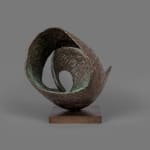Barbara Hepworth 1903-1975
39.4 x 41.4 x 41.4 cm
Further images
The title of this work derives from a mathematical term for a form of curve that is dependent on another shape or curve. The location of a point on a taut string as it is either unwrapped from or wrapped around a curve is called an ‘involute of a curve’ and so the title implies a spiralling movement. Hepworth gave this title to several loosely related works, which are all pierced, ovoid forms. In 1946, she explained the appeal of the ovoid shape and its potential, stating: ‘I have always been interested in oval or ovoid shapes, the first carvings were simple realistic oval forms of the human head or of a bird. Gradually my interest grew in more abstract values – the weight, poise, and curvature of the ovoid as a basic form’.
In Involute (1956) and Involute II (1956) Hepworth extends the curve upwards at a greater angle, and in so doing increasingly opens the form to create wide apertures through which light can pass enabling more of the surrounding environment to become visible. Here, space is now inseparable from form. Although closely similar in shape, Involute II differentiates itself from Involute by its larger size and highly textured surface. There is a sense of movement in this piece, with the bronzes less contained and more dynamic than the earlier carvings and resembling a crashing wave or the roll of a hill more than a shell. Involute II echoes the three-foot tall Curved Form (Trevalgan) from the same year, which has a similar curved bottom and enveloping sides although lacking the turn inwards to form the complex curved enclosure we see here.
The lively surface and medium scale of Involute II prompt in the viewer an instinctive, active engagement. Indeed, in its composition the viewer is encouraged to observe the sculpture from multiple perspectives, to walk around it, to peer through its apertures and to touch its highly tactile, multi-faceted surfaces. Hepworth mused on the medium of sculpture in a 1972 interview when she observed how ‘every person looking at a sculpture should use his own body. You can’t look at sculpture if you are going to stand stiff as a ram rod and stare at it. With a sculpture you must walk around it, bend towards it, touch it, walk away from it’. In common with her contemporary, Henry Moore, the numerous openings of Involute II engender connections between the work and the surrounding landscape, a notion which is underscored by the biomorphic qualities of its form.
Provenance
with Gimpel Fils, LondonE. Somer, Bermuda, acquired from the above on 9 November 1965
Private collection, USA
Private collection, UK
Exhibitions
Nottingham, Castle Museum, Contemporary British Art, Arts Council of Great Britain, May - June 1957, another cast exhibited, touring to: Southampton, Art Gallery, June - July 1957; Cardiff, Bute Park, July - August 1957; Penzance, Penlee House, August - September 1957; Cheltenham, Imperial Gardens, September - October 1957London, Gimpel Fils, Recent Works by Barbara Hepworth, June 1958, cat no.3, another cast exhibited;
Brussels, British Embassy, A Private Exhibition of Contemporary British Paintings, Sculpture and Drawings, Summer 1958, cat no.15, another cast exhibited;
Leeds, City Art Gallery, Modern Sculpture, October - November 1958, cat no.34, another cast exhibited;
New York, Galerie Chalette, Hepworth, October - November 1959, cat no.16, another cast exhibited;
Zürich, Galerie Charles Lienhard, Barbara Hepworth, October 1960, cat no.3, another cast exhibited;
Cardiff, National Museum of Wales, Sculpture 1961, Arts Council of Great Britain, July -September 1961, cat no.18, another cast exhibited, touring to: Swansea, Glynn Vivian Art Gallery, September; Aberystwyth, National Library of Wales, October
Bangor, University College, November; Belfast, Queens University, 'Abstract Form and Life': Sculpture by Barbara Hepworth and Biological Models, April 1962, cat no.3, as '1959';
London, Whitechapel Art Gallery, Barbara Hepworth: An Exhibition of Sculpture from 1952-1962, May - June 1962, cat no.20, another cast exhibited;
London, Gimpel Fils, Barbara Hepworth, October - November 1972, cat no.3, another cast exhibited;
Galashiels, Scottish College of Textiles, Barbara Hepworth: A Selection of Small Bronzes and Prints, Arts Council of Great Britain, April - May 1978, cat no.8, another cast exhibited, touring to: Inverness, Museum and Art Gallery, June 1978; Dundee, Museum and Art Gallery, September 1978; Milngavie, Lillie Art Gallery, September - October 1978; Hawick, Museum and Art Gallery, October - November 1978; Ayr, Maclaurin Art Gallery, November - December 1978
Swansea, Glynn Vivian Art Gallery and Museum, Barbara Hepworth: A Sculptor's Landscape 1934-1974, October - November 1982, cat no.8, another cast exhibited, touring to: Bangor, Art Gallery, November - December 1982; Wrexham, Library Art Centre, December 1982 - January 1983; lsle of Man, Manx Museum, February 1983
Literature
J.P. Hodin, Barbara Hepworth, Neuchâtel, 1961, p169, cat no.218, another cast illustrated;Belfast, Queens University, 'Abstract Form and Life': Sculpture by Barbara Hepworth and Biological Models, April 1962, cat no.3, as '1959';
Cornwall Education Committee, Works of Art for Schools, Falmouth, 1980, pp5, 37, cat no.1 (groupG), another cast illustrated on the cover;
Tate Gallery, The Tate Gallery Acquisitions 1982-84, London, 1986, p198, no.T03749, another cast illustrated;
Matthew Gale and Chris Stephens, Barbara Hepworth: Works in the Tate Collection and the Barbara Hepworth Museum St Ives, London, 2004, pp151-153, 249, cat no.35, another cast illustrated;
Sophie Bowness (ed.), Barbara Hepworth: The Plasters The Gift to Wakefield, Farnham, 2011, p60, pl.54, another cast illustrated;
Sophie Bowness, Barbara Hepworth: The Sculptor in the Studio, London, 2017, pp75-76, another cast illustrated;
E. Clayton, Barbara Hepworth: Art & Life, London, 2021, p200, another cast illustrated






